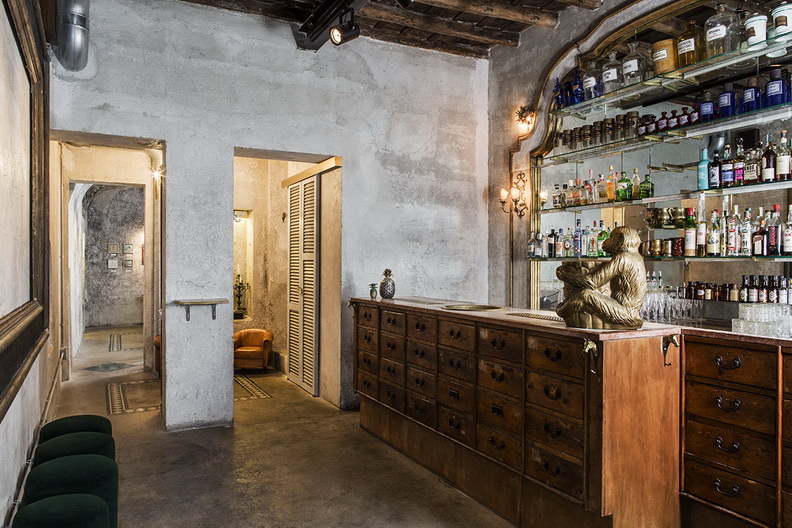Sacripante Art Gallery in Rome
Необычная арт-галерея в центре Рима на via Panisperna, неподалеку от площади Венеции и Колизея.
Дизайн разработан архитектором Giorgia Cerulli, совладелицей галереи, которая специализировалась на дизайне интерьеров для отелей, ресторанов и магазинов. Её стилистические исследования концентрируются на restyling of antiquities. Галерея начала свою работу в ноябре 2014
Дизайн разработан архитектором Giorgia Cerulli, совладелицей галереи, которая специализировалась на дизайне интерьеров для отелей, ресторанов и магазинов. Её стилистические исследования концентрируются на restyling of antiquities. Галерея начала свою работу в ноябре 2014
Tucked discretely behind a heavy metal door in one of Rome’s oldest neighbourhoods, with just a small cryptic banner indicating its presence, Sacripante Gallery feels more like a secret society venue than an art gallery. And indeed, once inside, this feeling is reinforced by a space that looks nothing like your typically bland “white cube” gallery.
Giorgia Cerulli is an architect whose final thesis was about interior lighting design. From 2008 she has worked as interior designer for hotels, restaurants and shops; her stylistic research is focused on the reuse and restyling of antiquities.
Rough plastered walls of dark grey, bare cement floors incorporating recovered floor tiles, high oak beam ceilings and cellar-like rooms exude a mystical, baroque atmosphere that harks back to the building’s past.
Built in the 18th century as a convent by Cardinal Sacripante, whom the gallery is named after, the place has been completely renovated by architect and co-owner Giorgia Cerulli, into an idiosyncratic gallery that reflects the sensibilities of the owners which include Giorgia’s sister Carlotta, a passionate art lover, and husband Alessandro Cattedra, an event manager.
The eerie roughness of the architecture is complemented by 1940s furniture such as lush velvet sofas and bronze & glass coffee tables; the result is both inviting and enchanting, transporting the visitor into the magical realm of an otherworldly members-only art-club.
Naturally, no such club would be complete without a proper bar: modelled as a turn-of-the-century chemist’s, complete with wooden storage-drawers, apothecary jars and potion bottles, the hidden cocktail bar alludes to a speakeasy, the secret establishments during Prohibition in America. Fittingly enough, the bar serves drinks in original decorated glasses from the 1920s and 30s.
The bar’s design also pays homage to the Via Panisperna boys: named after the gallery’s address, they were a group of young physicists and chemists in the 1930s based in the Physics Institute down the street, who discovered slow neutrons in 1939 —a discovery that subsequently led to the design of the nuclear reactor and the atomic bomb.
Dedicated to investigating and exploring Lowbrow art through organising only two exhibitions per year, Sacripante Gallery opened auspiciously in November 2014 (Giorgia gave birth to her daughter Lea on the opening day) with an exhibition of local street artists Lucamaleonte and David Diav? Vecchiato curated by Rossana Calbi & Giulia Piccioni. Lowbrow, otherwise known as pop surrealism, couldn’t be a better fit for the gallery’s quirky eclecticism.
Bringing together “two at first glance contradictory concepts, surrealism preoccupation with dreams and the unconscious and popular culture’s obsession with surface and commonalities”, as Kirsten Anderson has written in the New York Times, the Lowbrow movement mirrors the confluence of the impish, punk iconoclasm of Sacripante Gallery’s art exhibitions and the austere, decadent nostalgia of the building itself.
In experiencing the one against and through the other, the visitor transitions from a distanced viewer to an insider, admitted into the artists’ realm.
***
Photo by Serena Eller
***
via Yatzer













No comments:
Post a Comment